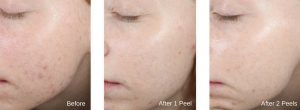How does a skin peel work, and is it the right treatment for you? This is a really common question in my clinic. I’m going to give you some basics about skin peels so you know what to expect and whether it’s suitable for you.
What is a skin peel?
A skin peel, also known as a chemical peel, is a method of shedding the top layer of skin cells, to make your skin brighter and healthier. We apply the solution to the skin, usually with a small brush, and then leave it on for several minutes.
The solutions are made up a mixture of acids, often from fruits and vegetables as well as other things. Some common acids for peel solutions are glycolic acid (from sugar), mandelic acid (from almonds), lactic acid (from milk), tartaric acid (from grapes), salicylic Acid (from willow bark) and citric acid from fruits. They are AHA’s or BHA’s which stands for Alpha (or Beta) Hydroxy Acids.
What does a skin peel feel like?
Most skin peels are not at all painful. You will feel a tingling, itching or sometimes warm sensation. There are deeper peels (like a TCA peel) which are more uncomfortable.
How does the skin peel work?
The acid in the solution breaks down the ‘glue’ which holds your skin cells together. This chemical reaction is the reason that peels get called ‘chemical peels’, not because battery acid is put on your skin! This loosening of the skin cells makes it easier for your skin to shed, getting rid of dull dead cells.
The peel solution is more acidic than your skin (your skin is naturally acidic) so it lowers the pH level temporarily. This is how it breaks apart the skin.
What will you look like after a skin peel?
Gone are the days of peels which literally see your skin dropping off your face like a horror movie. Most clinic skin peels are progressive, with an increase in strength, little by little each time. This ‘stepping up’ process means you avoid problems and lengthy downtime.
Immediately afterwards you will look fresh, healthy and glowing, and possibly a little pink. As your peels get stronger you can start to look more red. You may get a little dryness and flaking following your peel, but you won’t get great chunks of skin shedding after an AHA or BHA peel.
How does a skin peel combat ageing?

The skin is made up of living cells and dead cells, and as we get older the dead cells will increase and can become slow to slough away. Plus with age you will start to see brown patches of pigmentation, as well as open pores and fine lines.
A skin peel gets rid of dead cells, and gives your skin a wake up call. This makes it speed up and produce stronger healthier clearer skin cells. After a good regime of skin peels you will also see smoother skin with less fine lines and less pigmentation.
Can a skin peel work for acne?

Yes the right skin peel can improve acne. A skin peel can break apart the thickened skin which builds up with acne. It can also mop up the excess oil and restore healthy balanced skin cells. By shedding dead skin cells a peel will also help unclog pores and reduce the chance of more spots appearing. Salicylic Acid and Mandelic Acid are both effective for acne.
Who will benefit from a peel?
Mostly anyone can have a peel for either a general overhaul or to treat a specific concern. (There are exceptions to this, for example if you have a skin infection, damaged skin or other medical conditions.)
It’s a great treatment which can be performed in around 30 minutes. After a course of around 3-6 treatments you will start to notice a visible difference.
I hope this article has helped you understand more about skin peels. I’m a big fan of AHA skin peels as they provide a great overhaul for most skins.
If you have any more questions feel free to email me at: rach@radiantliving.co.uk.
Or for information on prices visit the skin peel page here.

